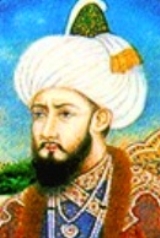
Humayun
Overview
Nasir ud-din Muhammad Humayun was the second Mughal Emperor
who ruled present day Afghanistan
, Pakistan
, and parts of northern India
from 1530–1540 and again from 1555–1556. Like his father, Babur
, he lost his kingdom early, but with Persian
aid, he eventually regained an even larger one. On the eve of his death in 1556, the Mughal empire
spanned almost one million square kilometers.
He succeeded his father in India in 1530, while his half-brother Kamran Mirza
, who was to become a rather bitter rival, obtained the sovereignty of Kabul
and Lahore
, the more northern parts of their father's empire.
Mughal Empire
The Mughal Empire , or Mogul Empire in traditional English usage, was an imperial power from the Indian Subcontinent. The Mughal emperors were descendants of the Timurids...
who ruled present day Afghanistan
Afghanistan
Afghanistan , officially the Islamic Republic of Afghanistan, is a landlocked country located in the centre of Asia, forming South Asia, Central Asia and the Middle East. With a population of about 29 million, it has an area of , making it the 42nd most populous and 41st largest nation in the world...
, Pakistan
Pakistan
Pakistan , officially the Islamic Republic of Pakistan is a sovereign state in South Asia. It has a coastline along the Arabian Sea and the Gulf of Oman in the south and is bordered by Afghanistan and Iran in the west, India in the east and China in the far northeast. In the north, Tajikistan...
, and parts of northern India
India
India , officially the Republic of India , is a country in South Asia. It is the seventh-largest country by geographical area, the second-most populous country with over 1.2 billion people, and the most populous democracy in the world...
from 1530–1540 and again from 1555–1556. Like his father, Babur
Babur
Babur was a Muslim conqueror from Central Asia who, following a series of setbacks, finally succeeded in laying the basis for the Mughal dynasty of South Asia. He was a direct descendant of Timur through his father, and a descendant also of Genghis Khan through his mother...
, he lost his kingdom early, but with Persian
Safavid dynasty
The Safavid dynasty was one of the most significant ruling dynasties of Iran. They ruled one of the greatest Persian empires since the Muslim conquest of Persia and established the Twelver school of Shi'a Islam as the official religion of their empire, marking one of the most important turning...
aid, he eventually regained an even larger one. On the eve of his death in 1556, the Mughal empire
Mughal Empire
The Mughal Empire , or Mogul Empire in traditional English usage, was an imperial power from the Indian Subcontinent. The Mughal emperors were descendants of the Timurids...
spanned almost one million square kilometers.
He succeeded his father in India in 1530, while his half-brother Kamran Mirza
Kamran Mirza
Kamran Mirza, sometimes known simply as Kamran, was the second son of Babur Mirza, the founder of the Mughal dynasty.Kamran Mirza was born in Kabul...
, who was to become a rather bitter rival, obtained the sovereignty of Kabul
Kabul
Kabul , spelt Caubul in some classic literatures, is the capital and largest city of Afghanistan. It is also the capital of the Kabul Province, located in the eastern section of Afghanistan...
and Lahore
Lahore
Lahore is the capital of the Pakistani province of Punjab and the second largest city in the country. With a rich and fabulous history dating back to over a thousand years ago, Lahore is no doubt Pakistan's cultural capital. One of the most densely populated cities in the world, Lahore remains a...
, the more northern parts of their father's empire.
Discussions

